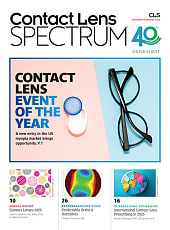THINKING OUTSIDE THE BOX
Three ways to boost business with cross-merchandising strategies
By Erinn Morgan
The l.a.Eyeworks store in Los Angeles displays funky shoes from the store down the street. An independent retailer in Oregon buffs up her sunglass department with clothing and accessories from Oakley. Wal-Mart Opticals hang tags promoting eyewear specials on book bags in back-to-school departments.
Cross-merchandising and crosspromotional strategies can be applied at both chain and independent optical locations. Following are three examples of how enterprising eyecare professionals each stepped out of their own boxes.
THE PRODUCT SWAP
Innovative eyewear designer and retailer l.a.Eyeworks' most recent was a collaboration with John Fluevog Shoes, says Brent Zerger, director of communications and retail operations at l.a.Eyeworks in Los Angeles.
"We presented Fluevog shoes in our mothership Melrose Avenue store displayed with l.a.Eyeworks frames and sunglasses," he says. "In turn, Fluevog showed our sunglasses among their bespoke footwear collections at their flagship location down the street."
Located only a few blocks away from each other, the stores can easily send clients to one another.
"We are known for our strength in merchandising unique items that complement the story of our brand," says l.a.Eyeworks director of marketing Angela Gee. "The collaboration with John Fluevog offered us a great opportunity to engage customers in conversation about fashion, individuality, and edginess—topics that positively reinforce our own point of view."
| Cross Merchandising Gets Validated |
|---|
| A study released in June 2007 confirms the importance of interdepartmental cross merchandising in building sales and market share. Conducted by the Global Market Development Center in Colorado Springs, Colo., the study proved that planning ahead with crossmerchandising promotions before a major sales season or holiday can help increase sales. While the results are gleaned from chain store sales, the same concept can be applied to independent retailers who make the effort to cross merchandise with other local stores or promote their own category sales in different departments. |
Both sides of this equation agreed that the pairing succeeded mainly because they harmonized.
"Our products look great together, plus our passion for color and our sense of humor all reflect shared sensibilities," says Keith Manship, Los Angeles manager of John Fluevog Shoes. "One of the interesting returns on the effort was that many responses to the sunglasses gave us insight on how our clients think about Fluevog shoes."
SIGNAGE FOR SALES
Large chain retailers with optical departments have the strategic advantage of cross merchandising and cross promoting within their own stores. "We do cross merchandise, but it is dependent on the product's relevance in store," says Jeff McCalister, senior vice president of the optical division at Wal-Mart. "Back-to-school is a good time; that's when people are coming in for computers, backpacks, and notebooks."

Stressing the strong tie between eyewear and other accessories, l.a.Eyeworks has a cross-merchandising program with a local upscale shoe shop that embraces a similar creative aesthetic
He says the goal is to get the parent to say, 'Hey, you have a vision center, and I hadn't thought about that for my children's eyecare.'
Wal-Mart Optical also capitalizes on the popularity of eyewear brands that tie into other products. "Hannah Montana is really big, and we have great frames in that collection," says McCallister. "So, we put Hannah Montana signage up in front of the vision centers. We definitely led some sales as a by-product of that."
NEW SALES CATEGORIES
Some retailers go above and beyond the cross-merchandising strategy to actually bring in and sell other related product categories in their optical shops.
In Sandy, Oregon, Wy'east Optics has had success with stocking eyewear, clothing, and accessories from Oakley. "I am in a rural area, but on the way to the Mt. Hood ski area, so there is tons of stuff that could be integrated into the mix here," says owner Cheri McMahan.
Wy'east, which is located next to a Starbucks in a busy retail center, carried Oakley accessories in addition to a large selection of the brand's sunglass and ophthalmic styles. "I merchandised it from gigantic chains that we hung from the ceiling—I used a clip hook to attach each item to the chain," she says.
While McMahon saw many eyewear customers purchase Oakley accessories because she was carrying them, she also noticed an increase of customers drawn into Wy'east by the Oakley goods (which were also in the store window). Many of the latter often ended up buying eyewear.
"We definitely experienced both types of customers, and around Christmas, I even had people buying gift certificates," she says. People coming in for eyewear would buy an Oakley item, too, she adds. "Even people who didn't buy eyewear would still buy something."
With the possibility of a new customer base and an overall increase in business, the strategy can be implemented by nearly any practice that has retail establishments nearby. EB



